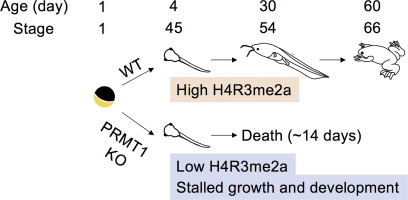当前位置:
X-MOL 学术
›
BBA Gen. Subj.
›
论文详情
Our official English website, www.x-mol.net, welcomes your
feedback! (Note: you will need to create a separate account there.)
Knocking out histone methyltransferase PRMT1 leads to stalled tadpole development and lethality in Xenopus tropicalis.
Biochimica et Biophysica Acta (BBA) - General Subjects ( IF 2.8 ) Pub Date : 2019-11-15 , DOI: 10.1016/j.bbagen.2019.129482 Yuki Shibata 1 , Morihiro Okada 1 , Thomas C Miller 1 , Yun-Bo Shi 1
Biochimica et Biophysica Acta (BBA) - General Subjects ( IF 2.8 ) Pub Date : 2019-11-15 , DOI: 10.1016/j.bbagen.2019.129482 Yuki Shibata 1 , Morihiro Okada 1 , Thomas C Miller 1 , Yun-Bo Shi 1
Affiliation

|
BACKGROUND
Asymmetric arginine dimethylation of histone H4R3 to H4R3me2a by protein arginine methyltransferase 1 (PRMT1) has been implicated to play a key role in gene activation throughout vertebrates. PRMT1 knockout in mouse leads to embryonic lethality. This and the uterus-enclosed nature of the mouse embryo make it difficult to determine the development role of PRMT1 in mammals.
METHODS
We took advantage of the external development of the diploid anuran Xenopus tropicalis and adapted the TALEN genome editing technology to knock out PRMT1 in order to investigate how PRMT1 participates in vertebrate development.
RESULTS
We observed that PRMT1 knockout had no apparent effect on embryogenesis because normally feeding tadpoles were formed, despite the reduced asymmetric H4R3 di-methylation (H4R3me2a) due to the knockout. However, PRMT1 knockout tadpoles had severely reduced growth even with normal growth hormone gene expression. These tadpoles were also stalled in development shortly after feeding began at stages 44/45 and died within 2 weeks, well before the onset of metamorphosis. In situ analyses revealed broad cessation or drastic reduction in cell proliferation in diverse organs including the eye, brain, spinal cord, liver, and intestine.
CONCLUSIONS
Our findings suggest that PRMT1 is not required for embryogenesis but is a key regulator for normal progression of vertebrate development and growth.
GENERAL SIGNIFICANCE
The similarities and differences between PRMT1 knockout Xenopus tropicalis and mouse suggest that two distinct phases of vertebrate development: early embryogenesis and subsequent growth/organ maturation, have different but evolutionally conserved requirement for epigenetic modifications.
中文翻译:

敲除组蛋白甲基转移酶PRMT1会导致非洲爪蟾development的发育停滞和致死性。
背景技术已暗示蛋白精氨酸甲基转移酶1(PRMT1)使组蛋白H4R3变为H4R3me2a的不对称精氨酸二甲基化在整个脊椎动物的基因激活中起关键作用。小鼠PRMT1敲除导致胚胎致死率。小鼠胚胎的这种和子宫封闭的性质使得很难确定PRMT1在哺乳动物中的发育作用。方法我们利用二倍体无脊椎动物非洲爪蟾的外部发育优势,并采用TALEN基因组编辑技术来敲除PRMT1,以研究PRMT1如何参与脊椎动物的发育。结果我们观察到PRMT1基因敲除对胚胎发生没有明显影响,因为形成了正常喂养的t,尽管由于基因敲除导致不对称的H4R3二甲基化(H4R3me2a)减少。然而,即使具有正常的生长激素基因表达,PRMT1基因敲除t也已严重降低了生长。这些t在喂食开始于44/45阶段后不久就停止了发育,并在变态开始之前的2周内死亡。原位分析表明,包括眼,脑,脊髓,肝和肠在内的各种器官的细胞增殖广泛停止或急剧减少。结论我们的研究结果表明PRMT1不是胚胎发生所必需的,而是脊椎动物正常发育和生长的关键调节剂。一般意义PRMT1基因敲除非洲爪蟾和小鼠之间的异同表明脊椎动物发育的两个不同阶段:早期胚胎发生和随后的生长/器官成熟,
更新日期:2019-11-15
中文翻译:

敲除组蛋白甲基转移酶PRMT1会导致非洲爪蟾development的发育停滞和致死性。
背景技术已暗示蛋白精氨酸甲基转移酶1(PRMT1)使组蛋白H4R3变为H4R3me2a的不对称精氨酸二甲基化在整个脊椎动物的基因激活中起关键作用。小鼠PRMT1敲除导致胚胎致死率。小鼠胚胎的这种和子宫封闭的性质使得很难确定PRMT1在哺乳动物中的发育作用。方法我们利用二倍体无脊椎动物非洲爪蟾的外部发育优势,并采用TALEN基因组编辑技术来敲除PRMT1,以研究PRMT1如何参与脊椎动物的发育。结果我们观察到PRMT1基因敲除对胚胎发生没有明显影响,因为形成了正常喂养的t,尽管由于基因敲除导致不对称的H4R3二甲基化(H4R3me2a)减少。然而,即使具有正常的生长激素基因表达,PRMT1基因敲除t也已严重降低了生长。这些t在喂食开始于44/45阶段后不久就停止了发育,并在变态开始之前的2周内死亡。原位分析表明,包括眼,脑,脊髓,肝和肠在内的各种器官的细胞增殖广泛停止或急剧减少。结论我们的研究结果表明PRMT1不是胚胎发生所必需的,而是脊椎动物正常发育和生长的关键调节剂。一般意义PRMT1基因敲除非洲爪蟾和小鼠之间的异同表明脊椎动物发育的两个不同阶段:早期胚胎发生和随后的生长/器官成熟,











































 京公网安备 11010802027423号
京公网安备 11010802027423号